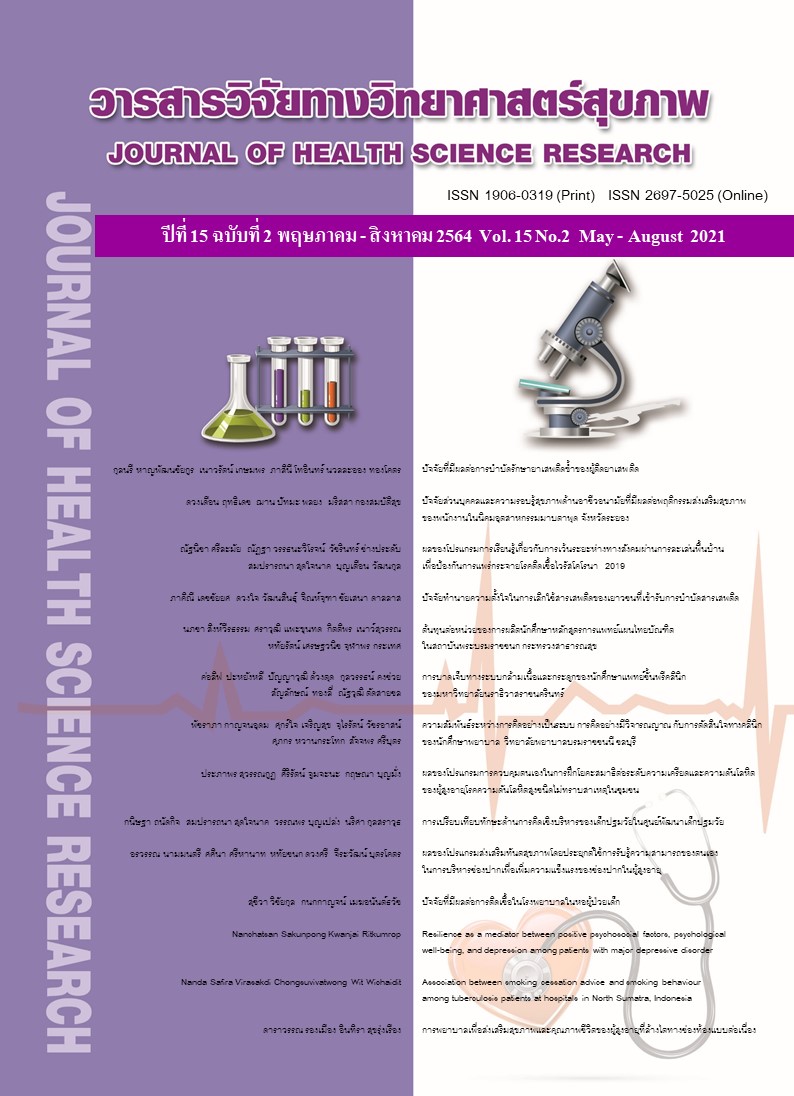ผลของโปรแกรมการเรียนรู้เกี่ยวกับการเว้นระยะห่างทางสังคมผ่านการละเล่นพื้นบ้านเพื่อป้องกันการแพร่กระจายโรคติดเชื้อไวรัสโคโรนา 2019
Main Article Content
บทคัดย่อ
บทนำ : โรงเรียนมีความเสี่ยงสูงต่อการระบาดโรคติดเชื้อไวรัสโคโรนา 2019 (โควิด 19) การพัฒนาสมรรถนะของนักเรียนด้านการเว้นระยะห่างทางสังคม มีความสำคัญต่อการป้องกันการแพร่กระจายของโรค
วัตถุประสงค์การวิจัย : เพื่อเปรียบเทียบสมรรถนะการป้องกันการแพร่กระจายโรคโควิด 19 ระหว่างก่อน หลังสิ้นสุดกิจกรรมที่ 2 และวัดซ้ำ 1 เดือนหลังได้รับโปรแกรมการเรียนรู้เกี่ยวกับการเว้นระยะห่างทางสังคมผ่านการละเล่นพื้นบ้าน
วิธีการวิจัย : การวิจัยกึ่งทดลองแบบกลุ่มเดียว วัดก่อนและวัดซ้ำหลังการทดลอง ตัวอย่าง คือ นักเรียนชั้นประถมศึกษาปีที่ 6 จำนวน 152 คน ตอบแบบสอบถาม 3 ครั้ง คือ ก่อน หลังสิ้นสุดกิจกรรมที่ 2 และวัดซ้ำ 1 เดือนหลังเข้าร่วมโปรแกรมฯ เพื่อป้องกันการแพร่กระจายโรคโควิด 19 แบบสอบถามสมรรถนะเกี่ยวกับการเว้นระยะห่างทางสังคมมี 4 ส่วน คือ ข้อมูลส่วนบุคคล (5 ข้อ) ความรู้ (15 ข้อ) ทัศนคติ
(8 ข้อ) และการปฏิบัติเกี่ยวกับการเว้นระยะห่างทางสังคม (12 ข้อ) โดยมีค่าความเที่ยงเท่ากับ .80, .82 และ .84 ตามลำดับ วิเคราะห์ข้อมูลด้วยความแปรปรวนแบบวัดซ้ำทางเดียว
ผลการวิจัย : สมรรถนะการป้องกันการแพร่กระจายโรคโควิด 19 เพิ่มขึ้นทุกด้าน (p<.01) ได้แก่ ด้านความรู้ (F=323.83, df 1.07, h2=0.683) ทัศนคติ (F=145.33, df 1.07, h2=0.490) และการปฏิบัติ(F=115.16, df 1.08, h2=0.433) และวัดซ้ำ 1 เดือนหลังได้รับโปรแกรมฯ มีคะแนนเฉลี่ยสูงกว่าก่อนและทันทีหลังการได้รับโปรแกรมฯ (ps<.001)
สรุปผล : โรงเรียนควรใช้โปรแกรมการเรียนรู้เกี่ยวกับการเว้นระยะห่างทางสังคมผ่านการละเล่นพื้นบ้านเพื่อเพิ่มสมรรถนะการเว้นระยะห่างทางสังคม เพื่อป้องกันการแพร่กระจายโรคโควิด 19
Downloads
Article Details
บทความที่ได้รับการตีพิมพ์เป็นลิขสิทธิ์ของวิทยาลัยพยาบาลบรมราชชนนี จังหวัดนนทบุรี
ข้อความที่ปรากฏในบทความแต่ละเรื่องในวารสารวิชาการเล่มนี้เป็นความคิดเห็นส่วนตัวของผู้เขียนแต่ละท่านไม่เกี่ยวข้องกับวิทยาลัยพยาบาลบรมราชชนนี จังหวัดนนทบุรี และคณาจารย์ท่านอื่น ในวิทยาลัยฯ แต่อย่างใด ความรับผิดชอบองค์ประกอบทั้งหมดของบทความแต่ละเรื่องเป็นของผู้เขียนแต่ละท่าน หากมีความผิดพลาดใด ๆ ผู้เขียนแต่ละท่านจะรับผิดชอบบทความของตนเองแต่ผู้เดียว
เอกสารอ้างอิง
The Johns Hopkins Department of Civil and Systems Engineering. Covid-19 dashboard by the center for systems science and engineering (csse), Johns Hopkins University (JHU) [internet]. 2020 [cited 2020 Apr 15]; Available from: https://gisanddata.
Worldometers. Covid-19 coronavirus pandemic, Worldometers [internet] 2020. [cited 2020 Apr 7]; Available from: https://www.worldometers.info/coronavirus/.
Centers for Disease Control and Prevention. Interim guidance on management of coronavirus disease 2019 (covid-19) in correctional and detention facilities. Centers for Disease Control and Prevention [internet]. 2021 [cited 2020 Jul 21]; Available from: https://www.cdc.gov/cor onavirus/2019ncov/community/correctiondetention/guidance-correctional-detention HTML.
Fong MW, Gao H, Wong JY, Xiao J, Shiu EYC, Ryu S, Cowling BJ. Nonpharmaceutical measures for pandemic influenza in nonhealthcare settings—social distancing measures. Emerg Infect Dis. 2020;26(5): 976-84. doi: 10.3201/eid2605.190995.
Wilder-Smith A, Freedman DO. Isolation, quarantine, social distancing and community containment: pivotal role for old-style public health measures in the novel coronavirus (2019-ncov) outbreak. J Travel Med. 2020;27(2):taaa020. doi: 10.1093/jtm/taaa020.
World Health Organization. Covid-19 infection prevention and control. World Health Organization [Internet]. 2020 [cited 2020 May 21]; Available from: https:// www.who.int/docs/defaultsource/wrindia/sameeksha/covid-ipc-sameeksha-vol3.pdf?sfv rsn=ca3feaf3_2.
Bloom BS. Handbook on formative and summative evaluation of student learning. New York: Mcgraw-Hill Book Co.; 1971.
Bloom BS. Taxonomy of educational objectives: Cognitive domain. New York: McKay; 1956.
Piaget J. The construction of reality in the child. London Routledge & Kegan Paul; 1955.
Sallis JF, Owen N, Fisher E. Ecological models of health behavior. In: Glanz K, Rimer BK, Viswanath K, editors. Health behavior: Theory, research, and practice. 5th ed. San Francisco, CA: Jossey-Bass, Wiley; 2015.
Shadish WR, Cook TD, Campbell DT. Experimental and quasi-experimental designs for generalized causal inference/william r. Shedish, thomas d. Cook, donald t. Campbell: Boston: Houghton Mifflin; 2002.
Thyer BA. Quasi-experimental research designs Thyer BA, editor. New York, Oxford: New York, Oxford: Oxford University Press; 2012.
Ojose B. Applying Piaget’s theory of cognitive development to mathematics instruction. Math Educ. 2008;18(1):26-30.
Babakr ZH, Mohamedamin P, Karwan K. Piaget’s cognitive developmental theory: Critical review. Educ Quarterly Reviews. 2019;2(3):517-24. doi: 10.31014/aior.19 93.02.03.84.
Kuder GF, Richardson MW. The theory of the estimation of test reliability. Psychometrika. 1937;2(3):151-60. doi: 10. 1007/BF02288391.
Cudeck R. A comparative study of indices for internal consistency. Educ Meas. 1980;17(2):117-30. doi: 10.1111/j. 1745-3984.1980.tb00820.x.
Cronbach LJ. Coefficient alpha and the internal structure of tests. Psychometrika. 1951;16(3):297-334. doi: 10.1007/BF02 310555.
Bathke AC, Schabenberger O, Tobias RD, Madden LV. Greenhouse–geisser adjustment and the anova-type statistic: Cousins or twins? Am Stat. 2009; 63(3):239-46. doi: 10.1198/tast.2009.08187.
Farr MJ. The long-term retention of knowledge and skills: A cognitive and instructional perspective. Arlington, VA: Springer-Verlag New York; 2012.
YILDIZ E, ŞİMŞEK Ü, AĞDAŞ H. The effects of educational game-integrated group research method on academic achievement, attitude towards school, and retention of knowledge in teaching regulatory system. Turk Sci Educ. 2018;15(3):91-105. doi: 10.12973/tused. 10239a.
Karakoç B, Eryılmaz K, Turan Özpolat E, Yıldırım I. The effect of game-based learning on student achievement: A meta-analysis study. Technol Knowl Learn. 2020. doi: 10.1007/s10758-020-09471-5.


